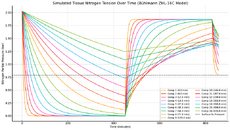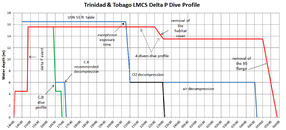Hi,
a few days ago I asked chatGPT if he could make me a simulate tissue tension graph based on Bühlmann ZHL-16C model for the following hyperbaric situation in a DRY pipeline.
Time: 00h00 start pressurisation
Time: 00h01 absolute pressure 2,57 bars
Time: 08h00 start depressurisation from 2,57 bars to 2,37 bars
Time 08h30 arrival at 2,37 bars
Time 14h30 start decompression from 2,37 bars to 1 bars
Time 15h00 arrival at 1 bars (surface)
I received this graph from the IA, but it looks a bit strange that the curves start from the top at 2 bars. I know that chatGPT is not yet always right that’s why I would like have your opinion about this graph.
a few days ago I asked chatGPT if he could make me a simulate tissue tension graph based on Bühlmann ZHL-16C model for the following hyperbaric situation in a DRY pipeline.
Time: 00h00 start pressurisation
Time: 00h01 absolute pressure 2,57 bars
Time: 08h00 start depressurisation from 2,57 bars to 2,37 bars
Time 08h30 arrival at 2,37 bars
Time 14h30 start decompression from 2,37 bars to 1 bars
Time 15h00 arrival at 1 bars (surface)
I received this graph from the IA, but it looks a bit strange that the curves start from the top at 2 bars. I know that chatGPT is not yet always right that’s why I would like have your opinion about this graph.





